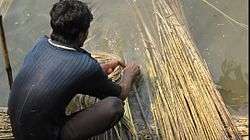Baishya Kapali
| Baishya Kapali বৈশ্য কপালী | |
|---|---|
| Religions | Hinduism |
| Languages | Bengali |
| Populated States | West Bengal, Bangladesh |
Baishya Kapalis (Bengali: বৈশ্য কপালী) simply known as the Kapalis (Bengali: কপালী) are a Bengali Hindu agricultural caste spread throughout West Bengal and Bangladesh. Minor populations are settled in Bihar, Jharkhand, Tripura, Orissa, Madhya Pradesh, Chhattisgarh, Maharashtra, Uttar Pradesh, Uttarakhand, Nepal, Assam and the Andaman and Nicobar Islands. The Kapalis have excelled in the cultivation of jute and manufacture of gunny bags. Baishya Kapalis or Kapalis are listed as Other Backward Class in West Bengal.[1]
Mythology
The ninth of the eleven Rudras of the thirty-three crore gods of Hindu pantheon is known as Kapali. According to Vamana Purana the Rudras were the sons of Kashyap and Aditi, while Matsya Purana mentions them as the offspring of the union between Brahma and Surabhi. The Harivamsa, an appendix to the Mahabharata mentions the Rudras as the children of Kashyap and Surabhi. The Adiparva of Mahabharata states that Kapali married the daughter of a sage and begot a son. According to Shourindra Kumar Ghosh, the progeny of their offspring came to be known as the Kapalis.[2]
History

kapalis are mainly as a landlord and their real surname is "Mondal" which is came from "Morol or Sardar". They have their " Paytee" like Brahmins but they are vashya. And their "Gurudev" is "khasayapa muni" so that their gotro is "kashayapa" .Risely mentions Kapalis as "a cultivating and weaving caste of Eastern Bengal, who claim to be the offspring of a Karmakar father and a Teli mother".[3] James Wise supports the view of a mixed caste born out of a Karmakar father and a Teli mother.[4]
The Brihaddharma Purana has no mention of the Kapalis. The Brahmavaivarta Purana categorized the Kapalis with the untouchables. According to a tradition, after inviting the five Brahmins from Kannauj, Adisur ordered the Kapalis to wash their feet. When the Kapalis refused, they were decreed as untouchables. Satish Chandra Mitra believed that Ballal Sena had decreed the Kapalis to be out castes, much like the Subarnabaniks, on the presumption that they were Buddhists.
After the demotion in the social strata, the Kapalis took to agriculture, dairy farming and business. The Kapalis excelled in the cultivation of jute and the preparation of gunny bags from jute. Gradually they became prosperous and some of them even became wealthy landowners. During the reign of Maharaja Pratapaditya, many Kapalis were employed in the government as well as in the army.[5] The Kapalis do not work as labourers, servants or domestic helps.[6]
Ethnology

The Kapalis usually have two gotras - Kashyap and Shiva. However Santosh Kumar Kundu mentions three gotras namely, Kashyap, Alimyan and Moudgalya.[5] Some Kapalis still use Kapali as their surname.
Religion
The Kapalis were originally Shaivites belonging to the school of Kashmir Shaivism, but later they embraced Buddhism. After the Bhakti movement, the Kapalis became Vaishnavas. In the present day, the majority of the Kapalis are Vaishnavas with a minority being Shaktas. The Kapalis follow the religious rituals with great devotion and piety.[7] The Kapalis have separate Brahmins known as Goswamis. Satish Chandra Mitra too mentions that the Kapalis have separate Brahmins to serve them.[7]
Eminent persons
References
- ↑ "List of Other Backward Classes (O.B.C.) Recognized by Govt. of West Bengal" (PDF). Archived from the original (PDF) on 2014-11-13.
- ↑ Ghosh, Shourindra Kumar. Bangali Jati Parichay [An Introduction of Bengali Castes] (in Bengali). Kolkata. p. 27.
- ↑ Rao, K.S. Krishna (2008). Global Encyclopaedia Of Brahamana Ethnography (2 Vols. Set). Global Vision Pub House. p. 259. ISBN 978-81-82202-08-5.
- ↑ Wise, James (1883). Notes on the Races, Castes and Trades of Eastern Bengal. London: Harrison and Sons. pp. 305–306.
- 1 2 Kundu, Santosh Kumar (2008). বাঙালী হিন্দু জাতি পরিচয় [An Introduction of Bengali Hindu Castes] (in Bengali). Kolkata: Presidency Library. p. 80. ISBN 978-81-89466-13-8.
- ↑ Mitra, Satish Chandra. Jashor Khulnar Itihas [The History of Jessore and Khulna] (in Bengali). Kolkata: Deys Publishing. p. 345.
- 1 2 Mitra, Satish Chandra. যশোর খুলনার ইতিহাস [The History of Jessore and Khulna] (in Bengali). Kolkata: Deys Publishing. p. 1035.